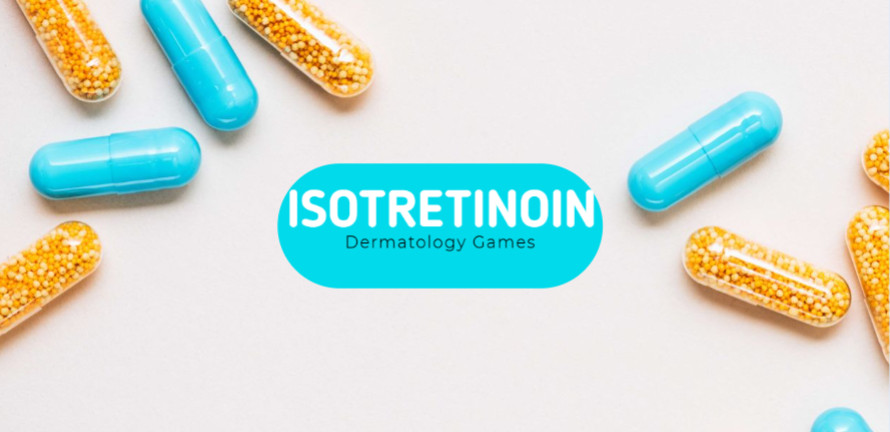
Isotretinoin
Indications of isotretinoin
- Severe nodulocystic acne.
- Moderate acne unresponsive to conventional therapy.
- Acne patients` who scar.
- Excessive oiliness.
- Severely depressed or dysmorphophobic acne patients.
- Solid facial edema : 0.2–1 mg/kg/day for 4–6 months.
- Sebaceous hyperplasia: start with 10 mg daily .
- Papulopustular rosacea : 0.3 mg/kg/day.
- Acne fulminans : prednisolone 0.5 to 1.0 mg/kg at least 2–4 weeks + Isotretinoin (0.1-0.5 mg/kg).
- Gram-negative folliculitis.
- Pyoderma faciale.
- Hidradenitis suppurativa.
- Eosinophilic pustular folliculitis (ofuji disease).
- Pityrosporum folliculitis.
- Aids-associated eosinophilic folliculitis : 0.5–1 mg/kg/day × 1–4 weeks.
- Dissecting cellulitis of the scalp: 0.5–1.5 mg/kg daily until 4 months after achieving a clinical remission.
- Ichthyoses.
- pityriasis rubra pilaris :1–1.5 mg/kg per day.
- Actinic folliculitis :0.35–0.5 mg/kg/day for 3–6 months.
- Disseminate and recurrent infundibulofolliculitis : 0.5 mg/kg/day for 16 weeks.
- Erythromelanosis follicularis faciei : isotretinoin : 0.1–1 mg/kg/day.
- Morphea.
- Discoid lupus erythematosus.
- Lichen sclerosis.
- Erythrokeratoderma.
- Darier disease: 0.5 mg/kg/day.
- Cutaneous sarcoidosis.
- Granuloma annulare : 0.5–0.75 mg/kg/day.
- Perforating diseases.
- Porokeratosis.
- Confluent and reticulated papillomatosis.
- Plane warts: 0.5 mg/kg/day for 2 months.
- Condylomata acuminata.
- Chemoprevention.
Dosage
- 0.5–1 mg/kg/day taken with a fatty meal.
- Cumulative dose of 120–150 mg/kg.
Mechanism of action
- Modulation of epidermal proliferation.
- Induction of orthokeratosis.
- Comedolysis.
- Inhibition of inflammation.
- Inhibition of sebum secretion.
Monitoring of isotretinoin
Baseline
- Pregnancy test (Women of childbearing).
- Fasting serum lipid levels
Stop if fasting triglycerides levels exceeds 800 mg/dl to reduce risk of pancreatitis.
- Liver functions(GGT).
AST and ALT are not liver-specific, being found in liver, muscle, and other tissues including red blood cells. GGT is a liver specific enzyme
source
- Consider eye examination if history of cataracts or retinopathy.
Follow Up
Labs
- In healthy patients with normal baseline lipid profile and liver function test results, repeated studies should be performed after two months of isotretinoin therapy.
- Renal function tests (occasional)
Special tests (Periodically as indicated by symptoms)
- Radiographic studies of significantly symptomatic joints with long-term therapy.
- Complete ophthalmologic examination if patients report visual changes ( eye dryness – night vision problems- color vision).
Routine complete blood cell count monitoring is not recommended.
source
Some authers recommend doing routine thyroid function tests at baseline and regular intervals but more studies are needed to confirm isotretinoin associated hypothyroidism.
Source1 Source2
Side effects
Common
Chelitis, dry skin, skin fragility, pruritus, epistaxis, dry mucous
membranes, conjunctivitis, photosensitivity, arthralgia/myalgia, reversible elevated serum lipid profile, desquamation of palms and soles, hair thinning/loss, nail changes, elevated liver enzyme levels, contact lens intolerance, decreased night vision, visual disturbances, depression, tinnitus, back pain, photosensitivity, pyogenic granulomas, paronychia, onycholysis, photophobia, headache, nausea, diarrhea, abdominal pain.
Rare
Pseudotumor cerebri, osteopenia/osteoporosis, hepatotoxicity, anaphylaxis, allergic vasculitis, major birth defects, violent behavior/aggression, psychosis, suicidal ideation, hearing impairment, cataracts/corneal opacities, premature epiphyseal closure, neutropenia, rhabdomyolysis, agranulocytosis, inflammatory bowel disease, pancreatitis, vascular thrombosis, stroke, seizures.
Contraindications
- Pregnancy or women seeking pregnancy.
- Non-compliance with contraception.
- Breastfeeding.
- Hypersensitivity.
- Blood donation: the donated blood might be given to a pregnant woman.
- Leukopenia .
- Moderate to severe hypercholesterolemia or hypertriglyceridemia.
- Signifcant hepatic or renal dysfunction.
- Suicidal ideation, pseudotumor cerebri.
- Vitamin A supplements.
The use of isotretinoin has not been studied in neonates, infants and children younger than 12 years of age.
Pregnancy and Lactation
- Category X.
- Lactation: Unknown whether distributed into breast milk; because of potential for serious adverse reactions in nursing infants, do not administer to women who are breastfeeding.
Drug interactions
- Pseudotumor cerebri : tetracycline, doxycycline, minocycline.
- Hypervitaminosis A : vitamin A
- Increased risk of bone loss: systemic steroids, phenytoin.
- Decreased efficacy of isotretinoin: progestin-only contraceptives.
- Increased dry skin: topical benzoyl peroxide and topical tretinoin.
- Increase risk of liver-related side effects: Methotrexate.
Precautions
- Female patients of childbearing potential must have at least one (in the US, two) negative pregnancy test(s) before starting treatment and must practice effective contraception for 1 month prior to, during, and for 1 month after completing therapy.
- Patients should not donate blood during treatment or for at least 1 month.
- Patients experiencing dry eye should stop wearing contact lenses and use saline wetting drops to avoid further complications.
Drug info
- A 6-month course of low-dose isotretinoin (e.g. 0.25–0.4 mg/kg/day, 40–70 mg/kg cumulative) can be effective in the treatment of moderate acne.
- Some patients require multiple courses of therapy.
- A temporary deterioration in acne frequently occurs when isotretinoin therapy is initiated but this does not normally require dose adjustment; very rarely, acne fulminans may develop.
- patients should be asked about having a family history of inflammatory bowel disease or concerning
gastrointestinal symptoms, referral to a gastroenterologist may be required. - Prescribing physicians should monitor their patients for any indication of IBD and depressive symptoms and educate their patients about the potential risks with isotretinoin.
- Start with 10 to 20 mg twice each day and gradually increasing the dosage during the first 4 to 6 weeks to avoid flare.
- Consider antiandrogen therapy for non responder females.
- Non responders include adolescents with nodulocystic acne under 16 years of age, pts with endocrine abnormalities, Scarred nodules and sinus tracts.
- The long-term benefit is related to the cumulative dosage, not to the duration of therapy.
- Isotretinoin‐induced pyogenic granuloma‐like lesions can arise in association with acne lesions and over nail folds: they tend to resolve on discontinuation of treatment.
- Ask about mood changes at each clinic visit.
#isotretinoin #Isotretinoin contraindications #Isotretinoin dosage #Isotretinoin drug interactions #Isotretinoin indications #Isotretinoin monitoring #Isotretinoin side effects